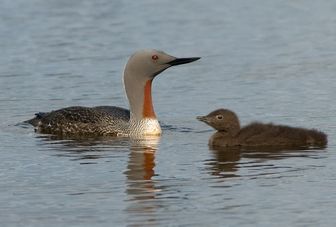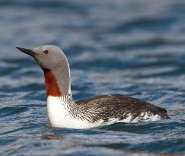Red-throated Diver
The Red-throated Loon or Red-throated Diver , is a migratory aquatic bird found in the northern hemisphere; it breeds primarily in Arctic regions, and winters in northern coastal waters. It is the most widely distributed member of the loon or diver family.

Red-Throated Diver - Smallest Diver Bird in the UK
 The red-throated diver (Gavia stellata) is also called the red-throated loon. The red-throated diver spends the summer in countries in the Arctic Circle, including Canada, Scotland, Northern Ireland and Russia. It spends the winters on the ocean waters in warmer climates like California, Japan and Morocco. It is the smallest ocean-diving bird that visits the UK.
The red-throated diver (Gavia stellata) is also called the red-throated loon. The red-throated diver spends the summer in countries in the Arctic Circle, including Canada, Scotland, Northern Ireland and Russia. It spends the winters on the ocean waters in warmer climates like California, Japan and Morocco. It is the smallest ocean-diving bird that visits the UK.
They love each other’s company and live in large flocks containing 200 to 1200 birds. When in large numbers, they get some protection from their predators – large sea gulls and Arctic foxes. If red-throated divers cannot flock on ocean shorelines, they will flock on lakes or even large pools in tundra areas. This species is not endangered, although many die in fishing nets or oil spills.
General Description
The red-throated diver (Gavia stellata) does, indeed, have a red throat in its adult summer plumage. The rest of this water bird’s body consists of a white belly, dove-grey head, a black tail and a back of brown spots against a grey background. This plumage changes to far less spectacular winter plumage of white and grey, with the red throat changed to white. Chicks sport a fuzzy dark brown down before their first molt.
Males are slightly larger than females. Females weigh only 2.18 pounds (988 grams) while males tip the scales at 5.42 pounds (2460 grams). Females have a wingspan of 41.73 inches (106 centimeters) while male wingspans can reach 45.67 inches (116 centimeters). Both males and females have long wings in relation to their body lengths – 20.86 inches (53 centimeters) for females and 27.16 inches (69 centimeters) for males. These long wings help the red-throated diver to begin flying directly from standing still.
Life Cycle and Habits
Males and females form a pair bond when they are 2 to 3 years old and keep the same sexual partner for life. The female lays one or three eggs per year. Although courtship begins on the water, the nests must be on dry ground. The male selects the nest site. Arctic foxes are adept at hunting these eggs. Males and females take turns sitting on the eggs. After 27 days, they hatch. Chicks follow their parents into the water as soon as their down dries. Seven weeks later, they molt and can fly.
Red-throated divers eat a wide variety of fish, mollusks, fish fry, fish eggs, small frogs, tadpoles, insects, snails, prawns and, rarely, aquatic plants. In order to pursue its prey, the bird can dive down to 29.52 feet (9 meters) and snatch the prey with its long bill.
Picture of the red-throated diver by Ómar Runólfsson, licensed under the Creative Commons Attribution 2.0 Generic license.
The Red-throated Diver is classified as Least Concern. Does not qualify for a more at risk category. Widespread and abundant taxa are included in this category.

Original source: Mark Jobling
Author: Mark Jobling
Permission: Some rights reserved
Family : Gaviidae
Genus : Gavia
Species : stellata
Authority : (Pontoppidan, 1763)
